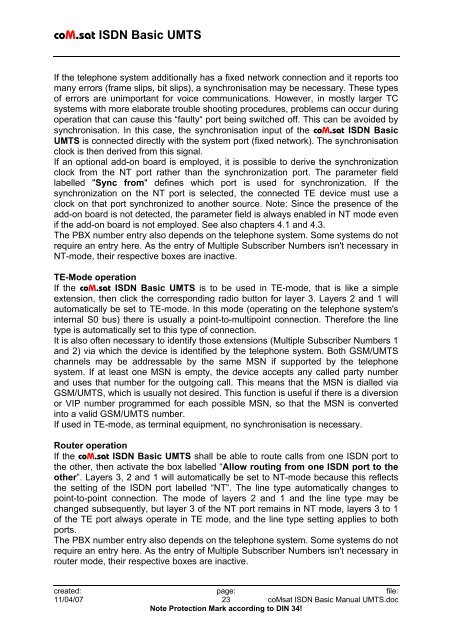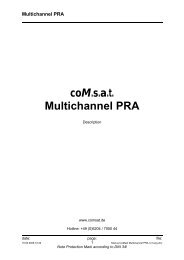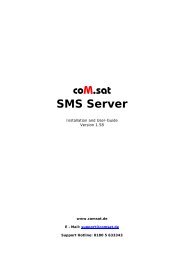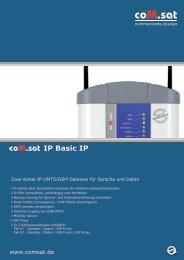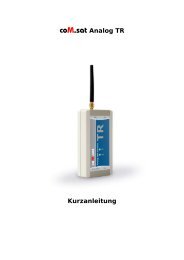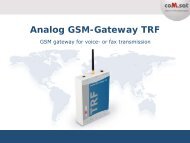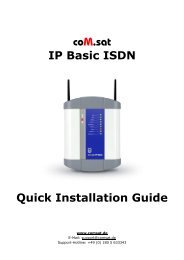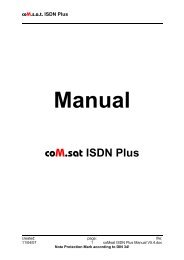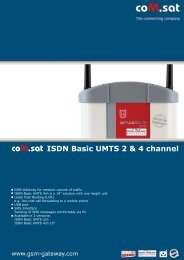coM.sat ISDN Basic UMTS
coM.sat ISDN Basic UMTS
coM.sat ISDN Basic UMTS
Create successful ePaper yourself
Turn your PDF publications into a flip-book with our unique Google optimized e-Paper software.
<strong>coM</strong>.<strong>sat</strong> <strong>ISDN</strong> <strong>Basic</strong> <strong>UMTS</strong><br />
If the telephone system additionally has a fixed network connection and it reports too<br />
many errors (frame slips, bit slips), a synchroni<strong>sat</strong>ion may be necessary. These types<br />
of errors are unimportant for voice communications. However, in mostly larger TC<br />
systems with more elaborate trouble shooting procedures, problems can occur during<br />
operation that can cause this “faulty“ port being switched off. This can be avoided by<br />
synchroni<strong>sat</strong>ion. In this case, the synchroni<strong>sat</strong>ion input of the <strong>coM</strong>.<strong>sat</strong> <strong>ISDN</strong> <strong>Basic</strong><br />
<strong>UMTS</strong> is connected directly with the system port (fixed network). The synchroni<strong>sat</strong>ion<br />
clock is then derived from this signal.<br />
If an optional add-on board is employed, it is possible to derive the synchronization<br />
clock from the NT port rather than the synchronization port. The parameter field<br />
labelled "Sync from" defines which port is used for synchronization. If the<br />
synchronization on the NT port is selected, the connected TE device must use a<br />
clock on that port synchronized to another source. Note: Since the presence of the<br />
add-on board is not detected, the parameter field is always enabled in NT mode even<br />
if the add-on board is not employed. See also chapters 4.1 and 4.3.<br />
The PBX number entry also depends on the telephone system. Some systems do not<br />
require an entry here. As the entry of Multiple Subscriber Numbers isn't necessary in<br />
NT-mode, their respective boxes are inactive.<br />
TE-Mode operation<br />
If the <strong>coM</strong>.<strong>sat</strong> <strong>ISDN</strong> <strong>Basic</strong> <strong>UMTS</strong> is to be used in TE-mode, that is like a simple<br />
extension, then click the corresponding radio button for layer 3. Layers 2 and 1 will<br />
automatically be set to TE-mode. In this mode (operating on the telephone system's<br />
internal S0 bus) there is usually a point-to-multipoint connection. Therefore the line<br />
type is automatically set to this type of connection.<br />
It is also often necessary to identify those extensions (Multiple Subscriber Numbers 1<br />
and 2) via which the device is identified by the telephone system. Both GSM/<strong>UMTS</strong><br />
channels may be addressable by the same MSN if supported by the telephone<br />
system. If at least one MSN is empty, the device accepts any called party number<br />
and uses that number for the outgoing call. This means that the MSN is dialled via<br />
GSM/<strong>UMTS</strong>, which is usually not desired. This function is useful if there is a diversion<br />
or VIP number programmed for each possible MSN, so that the MSN is converted<br />
into a valid GSM/<strong>UMTS</strong> number.<br />
If used in TE-mode, as terminal equipment, no synchroni<strong>sat</strong>ion is necessary.<br />
Router operation<br />
If the <strong>coM</strong>.<strong>sat</strong> <strong>ISDN</strong> <strong>Basic</strong> <strong>UMTS</strong> shall be able to route calls from one <strong>ISDN</strong> port to<br />
the other, then activate the box labelled “Allow routing from one <strong>ISDN</strong> port to the<br />
other”. Layers 3, 2 and 1 will automatically be set to NT-mode because this reflects<br />
the setting of the <strong>ISDN</strong> port labelled “NT”. The line type automatically changes to<br />
point-to-point connection. The mode of layers 2 and 1 and the line type may be<br />
changed subsequently, but layer 3 of the NT port remains in NT mode, layers 3 to 1<br />
of the TE port always operate in TE mode, and the line type setting applies to both<br />
ports.<br />
The PBX number entry also depends on the telephone system. Some systems do not<br />
require an entry here. As the entry of Multiple Subscriber Numbers isn't necessary in<br />
router mode, their respective boxes are inactive.<br />
created: page: file:<br />
11/04/07 23 <strong>coM</strong><strong>sat</strong> <strong>ISDN</strong> <strong>Basic</strong> Manual <strong>UMTS</strong>.doc<br />
Note Protection Mark according to DIN 34!


